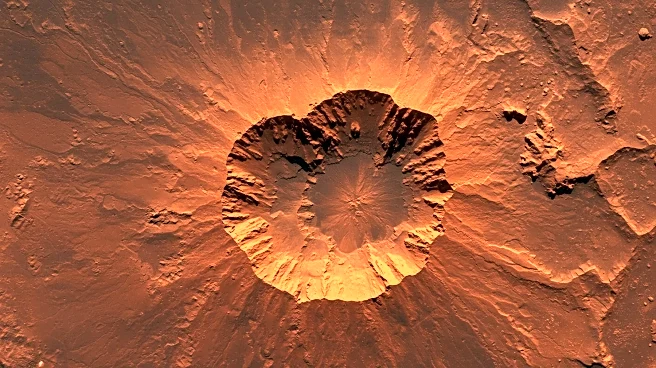What's Happening?
NASA's HiRISE camera on the Mars Reconnaissance Orbiter has captured new images of Candor Chasma, a significant canyon within Mars' Valles Marineris, the largest canyon system in the solar system. The images reveal layered sediment deposits several meters thick, suggesting tectonic activity after the canyon's formation. Valles Marineris, stretching 2,500 miles across Mars' equator, dwarfs Earth's largest canyon under Greenland's ice sheet. Unlike Earth's Grand Canyon, Valles Marineris is believed to have formed through volcanic activity, with subsequent landslides, floods, and erosion shaping its current form. The discovery of water beneath the surface in Candor Chasma by the ExoMars Trace Gas Orbiter in 2021 further highlights the canyon's geological significance.
Why It's Important?
The new findings from Candor Chasma could reshape planetary geologists' understanding of Mars' ancient environment and geological history. The presence of water beneath the surface suggests potential for future exploration and study, akin to Earth's permafrost regions. This discovery could have implications for understanding Mars' climate history and the potential for past life. The exploration of Valles Marineris is crucial for future Mars missions, as it may offer insights into the planet's geological processes and resources. The possibility of sending autonomous rovers and aerial vehicles to explore this challenging terrain could advance Mars exploration technology and strategies.
What's Next?
The German Space Agency's Valles Marineris Exploration project is considering deploying a swarm of autonomous rovers, crawlers, and uncrewed aerial vehicles to study the canyon's treacherous terrain. This initiative could pave the way for more detailed exploration of Mars' geological features and potential resources. Future missions may focus on understanding the tectonic movements and sediment layers revealed by the HiRISE images, providing deeper insights into Mars' geological history and environmental conditions.
Beyond the Headlines
The discovery of water in Candor Chasma raises questions about Mars' potential for sustaining life and its climate evolution. The layered sediments and tectonic activity suggest complex geological processes that could inform scientists about Mars' past environments. The exploration of Valles Marineris could also contribute to the search for life on Mars, as water is a key indicator of habitability. The technological advancements required for exploring such challenging terrains could have broader applications in space exploration and robotics.











